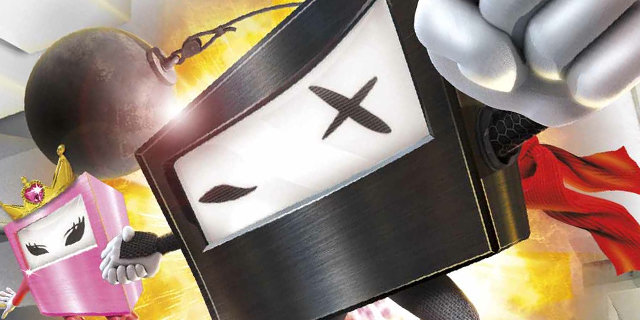Cubic Ninja, the latest title from developer AQ Interactive, clearly draws some inspiration from indie hit Super Meat Boy. You’re a cube of some sort named CC, navigating areas quickly and avoiding obstacles to try to rescue a girl. There are unlockable characters that modify the physics of how the character moves, there’s a detailed level editor for trying out others’ creations, and there’s this slick-yet-irreverent visual style. It’s not exactly that, though. This Ubisoft game was thought up as a way to take advantage of two things the 3DS does best: depth of field and tilt controls. You move the system back and forth, sliding the ninja into the background and through various three-dimensional holes and pathways. There are spikes to avoid, fans to navigate around and various switches and buttons to activate. Add in some enemies and boss battles, and that basically rounds out the experience.
If you’ve ever played a 3DS, you can see what problem this is leading to: 3D and tilt controls can’t work simultaneously. You need to be directly looking at the screen, or the depth effect just doesn’t work. AQ acknowledges this, as they set it to not run in 3D when tilt controls are used. You can opt for Circle Pad controls, and there you can see the depth. Of course, a circle pad doesn’t go in and out, so then you’ll need to hold down a modifier button when you want to go into the background. If you learn this, it’s more precise, but it’s a lot less fun.
The sensation of tilting the system around is, at its heart, an enjoyable experience. For years, labyrinth toys and games have used this type of gameplay, and the custom, course-based approach makes for a more varied experience. The problems stem from two things. First, the system doesn’t seem to calibrate based on your normal holding position, so it’s like a shirt that just doesn’t fit right: functional, but awkward. Second, there isn’t a very large center area, so whenever you try to aim for something in a middle area rather than a side or corner, it can be frustrating to get it to stop. We had to just try to get CC to fall past these holes and hallways and hope he got stuck there long enough for us to send him on his way.
Navigating the 100 story mode levels does take a decent amount of time, and were the basic controls more solid, it would be varied and interesting enough. (As it is, the whole game is coated in this film of quiet frustration.) The different characters change variables, like weight, friction, bounce and even size. They change things up a bit, and there are definitely some areas made easier with certain ninjas.
Cubic Ninja‘s level editor is fairly easy to use, and people who want to get into the game can use this to create some difficult challenges. It would be great to be able to delve into the community levels and try them out, but that framework just wasn’t implemented. There’s a half-measure, though: you can generate QR codes for levels and share them with others that way. It isn’t a great solution, and it doesn’t really allow the best creations to rise to the top, but at least die-hard fans can create some sort of community to share these in. (That Ubi and AQ didn’t make one themselves is a missed opportunity, even if it was just an official QR code sharing site and not an integrated in-game source.)
We love the idea of Cubic Ninja. It’s a gameplay concept that is designed for the system, with a unified theme and just a hint of personality. The execution, though, just can’t be ignored. It’s a fun game once you accept the constant , but as it is it’s hard to call it a purchase-worthy retail title.
Pros: Polished menus, decent level editor
Cons: Basically just the controls




















